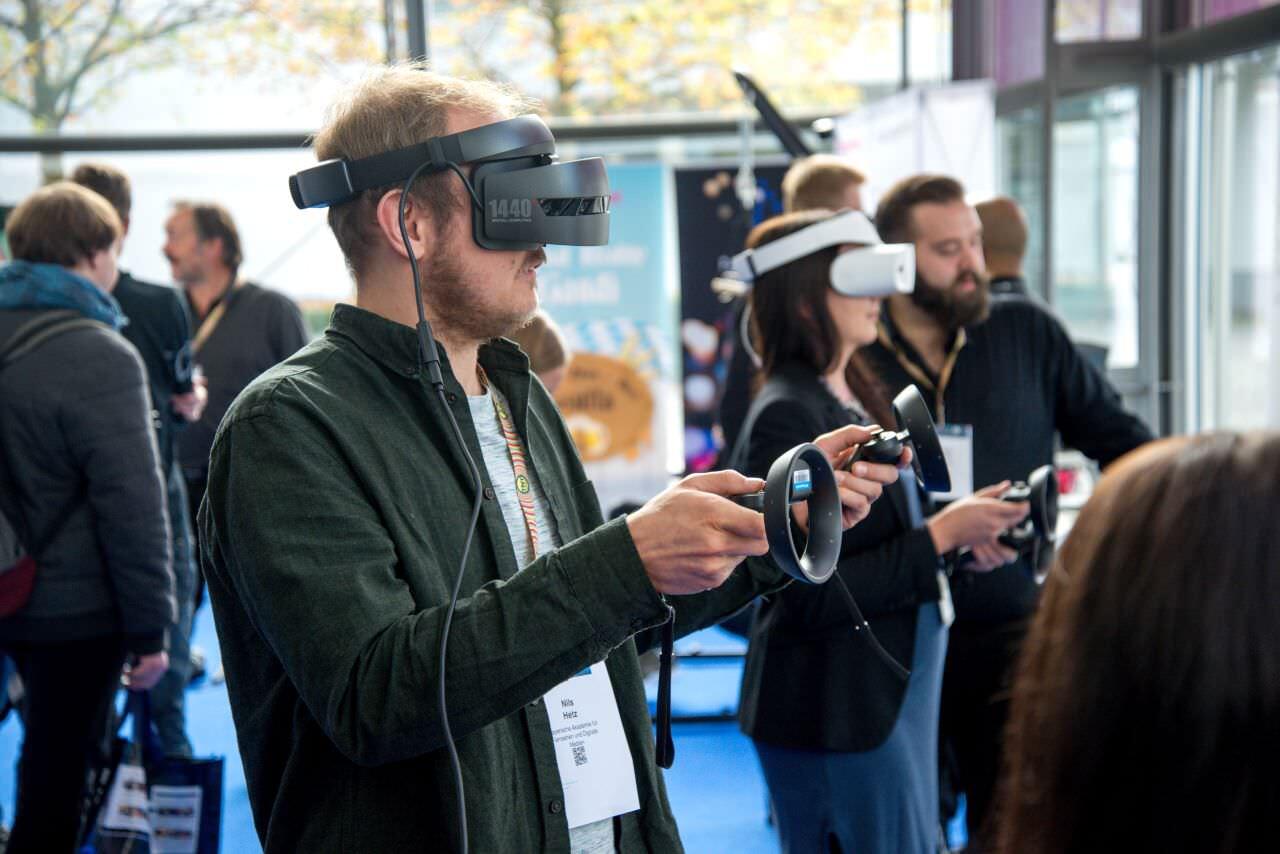
We will start by spoiling the surprise (sorry): Hybrid events are currently developing into the event model of the future. The current reality has led to a real boom in virtual events. From meetings to conferences: Everything now takes place virtually. But what happens after Corona? Will virtual and hybrid events disappear again, and we return to the old normal? We say: No!
The opportunities and strengths of virtual events (more on this later) are far too great for organisers not to make use of them in the future. If you now combine these with the strengths of real events, you automatically arrive at the concept that this article deals with: Hybrid events.
Hybrid event concepts have a touch of the future. They combine the best of traditional concepts with the innovative and above all interactive possibilities that the Internet gives us. Virtual reality, video chats and platforms for interactivity ensure that traditional events become hybrid events.
This new concept has many advantages: Among other things, hybrid concepts can address a much larger target group from different nations. Greater reach ensures more profit, and last but not least, hybrid events are also very sustainable. Find out what makes an event a hybrid, what advantages and disadvantages are involved and how you can create your next event hybrid in the following article.
What is a hybrid event?
Hybrid events are events that can be attended live by guests as well as by an interactive, virtual audience.
What sounds complicated is not: The precursor of hybrid events are big sports events like soccer world championships or the Olympic Games. In addition to the physically present audience, these events are broadcasted to millions of people.
The interactive character of such events turns them into hybrid events. We know this from television as well: For example, live Saturday evening shows in front of an audience, where television viewers can also help to shape the event by voting.
Hybrid events are therefore not new, but the importance of virtuality and interactivity has recently increased for events like these.
What can a hybrid event look like?
A study conducted during the Global Meeting Industry Day in April 2020 showed that 62% of event planners will hold hybrid style events, while 18% said that there will be more purely virtual events in the future.
But what will hybrid events look like in reality? Many types of events are particularly suitable for hybrid formats:
Hybrid Events Business-Edition: Trade fairs, exhibitions
An important speaker has no time to be on site at the trade fair? Stream him on a big screen!
Even innovative and still unusual methods, such as virtual reality and augmented reality, can be used at hybrid events. In virtual reality, a user moves in a virtually created environment, whereas in augmented reality, software is used to make objects visible in the real world.

Virtual Reality is always a highlight at fairs & events
Hybrid Events Business-Edition: Meetings, Conferences, Congresses, Product Presentations
Meetings, conferences and congresses are ideal for hybrid events. Contributions can be transmitted live to a non-attending audience and feedback possibilities via chat or circuits to non-attending persons can easily be realized.
Hybrid events at cultural events
Cultural events are also ideal as hybrid events. Media and art events in particular, play with virtual formats such as augmented reality. Competitions and shows now also thrive on interactive contributions by viewers on site and at various locations.
Hybrid events at sport events
As mentioned at the beginning, sport events on television are the precursor of hybrid events. Football, winter sports, the Olympic Games - all of them have been watched at the location, at public viewing stations or from home for decades. If an interactive character is now added through live chats, live betting or voting, sporting events become hybrid sports events.
What is not a hybrid event?
The key question is: What is the difference between a hybrid event and a live streamed event? The interactivity! The purely virtual transmission of a physical event to an online audience does not make your event hybrid. However, if you use software and technical platforms, such as a chat or survey, to provide feedback to this virtual audience, you have a hybrid event. The decisive factor is therefore the possibility of the event being co-designed by an on-site and online audience.
Accordingly, there are some events that are less suitable as hybrid events due to their character: Parades and carnivals for example. If the interactivity by an audience is not present, it’s extremely difficult. Also, internal events like teambuilding events and employee events usually require the personal presence of all participants.
Advantages of hybrid events
Why have interactive hybrid events become so popular lately? Here are the biggest advantages at a glance:
Advantage 1: More reach
One of the biggest advantages for hybrid events is obvious. With a virtual access to an event, you open yourself to guests who, for various reasons - time, money, space, environment - cannot attend in person. With this concept you can also easily reach a scattered target group all over the world. Of course, this greater reach also benefits you as an organizer - for example, with greater brand relevance and more profit.
Advantage 2: More interaction
Interactive online elements give your guests the feeling of being able to help to shape the hybrid event. Especially virtual and augmented reality are an exciting and new experience for many, which will remain in the memory for a long time. With these elements you can let your guests explore an event or show them the way.
Furthermore, it is an exciting possibility for you to stand out positively from other events. The more individual and unique your event, the better it will be remembered by your guests.
Advantage 3: ROI - Return on Investment
Granted: An interactive hybrid event first requires more planning and probably also costs for the acquisition of software or platforms. However, the higher investment costs are amortized quite quickly through a higher number of participants and thus higher sales through tickets. Furthermore, the software purchases are sustainable: they can be used for equivalent events in the future.
Advantage 4: Sustainability
As just mentioned, not only the one-time purchase of the software is a sustainable acquisition with regard to future events. With a hybrid event, you also help to do something good for the environment, keyword: Green Events. Through virtual participation, you save your guests ways that would otherwise probably have to be covered by flights or car trips. This saves a lot of CO2.
You are sustainable above all if you can combine many small events at different locations into one big event, thanks to the hybrid concept.
Advantage 5: Long term commitment
A hybrid event can help you to bind your guests to your event series in the long term. Especially with recurring series this makes sense.
First of all, virtuality lowers the threshold for participation: guests can decide more spontaneously, do not have to plan a trip or even an overnight stay. You also have the chance to convince your guests of a new innovative concept. Through the possibility of interaction, your event appears more individual and is more likely to be remembered.
Advantage 6: Follow-up and analysis
Digital participant management facilitates the evaluation of the participant data of your event and is fully compliant with DSGVO. You can then record, for example, which aspects or presentations the visitors found particularly exciting or which elements were not so well received. This also helps you to plan the next event.
Hybrid events: The disadvantages
We want to be completely open with you: Organizing a hybrid event naturally brings a few challenges.
Technical challenges
Organizing the virtual part of an event can be tricky, especially with new, unfamiliar software. The success of the event stands and falls with the functioning of the technology, because the cancellation rate for virtual events due to technical difficulties is very high.

High-quality technical equipment makes hybrid events cost-intensive
Personnel expenditure
In addition to looking after the guests on site, you now also need to look personnel after the virtual guests and, above all, to operate the technology to ensure a smooth flow.
Complex procedure
Instead of just one group of live participants, a hybrid event requires you to ensure, that both groups of participants are satisfied with different needs. This is especially challenging when it comes to the information needed to participate, but also to communicate during the event.
Possibly fewer live participants
If you offer virtual participation to your guests, you must be aware that this may be preferred to on-site participation. You may then have fewer guests sitting in the hall on site.
Holding a hybrid event: 5 tips
You have never organized a hybrid event before, but your next event should definitely be hybrid? Here we have summarized some tips for you. How to make your hybrid event a success!
As already mentioned: Your hybrid event stands and falls with functioning technology. This is what good planning is all about:
Internet
Make sure that the event location has a stable internet connection. You will probably need your own wired Internet line just for streaming the event. Transmission via WIFI is not an option for a hybrid event.Cameras
The choice and number of cameras depends on the type of event - panel discussion or close-up interview? Do you need shots from several angles and therefore several cameras? Then you need someone to handle these cameras. Which end devices are used by the guests receiving the stream? Which screens are available on site? Do you want to broadcast in HD? You should ask yourself all these questions in advance and long before your hybrid event.Microphones
Make sure that high quality microphones are used. Both for the speakers, the cameras, and the audience. The most useful here are wireless handheld microphones and microphone runners who can run through the audience to record questions. Everything the microphones record should be easily understood by the virtual audience of your hybrid event.
Especially if you are holding a hybrid event for the first time: It is best to play it safe. Hire a technician or service provider who can take care of all technical issues on site. Microphones, lighting, screens and even the virtual transmission should work smoothly. Be sure to test the hardware and software in several runs to make sure it works at the time of your hybrid event.
Make your event as individual and personal as possible - for the participants on site, but especially for the virtual guests. Involve them, let them participate and have a say. Create many rooms for conversations, chats, question and answer sessions, voting and feedback opportunities. Or establish a loyalty program or incentives for further events.
Hybrid events as an economic term are a relatively new concept. Just because you make use of this innovative concept does not mean that you cannot use it to advertise.
Content and event marketing fits perfectly to hybrid events. Not only can you draw attention to the event in advance and explain its concept in more detail, you can also make excellent use of social media channels to reach your new, much larger target group and encourage them to participate.
After the event you can use the material you produced in small parts for your social media channels, so you can promote yourself and stay in touch with your target group interactively.
Use virtual tours or 3D diagrams for your hybrid event. In the run-up to the event, you can get virtual and on-site guests in the right mood for the event - for example, in a video about theme-related delimited rooms. It can also be advantageous to share tours or diagrams during the event - for the orientation of guests on site and for virtual guests who get the impression that you are there live.
Conclusion:
Hybrid events are becoming more and more important in the event industry: This has many advantages. Both for guests, who can participate more independent, and for organizers. As an organizer, you can generate more coverage for your event, which ensures more relevance and more participants.
With exciting innovative elements, you can stand out from the crowd and leave a lasting impression.
